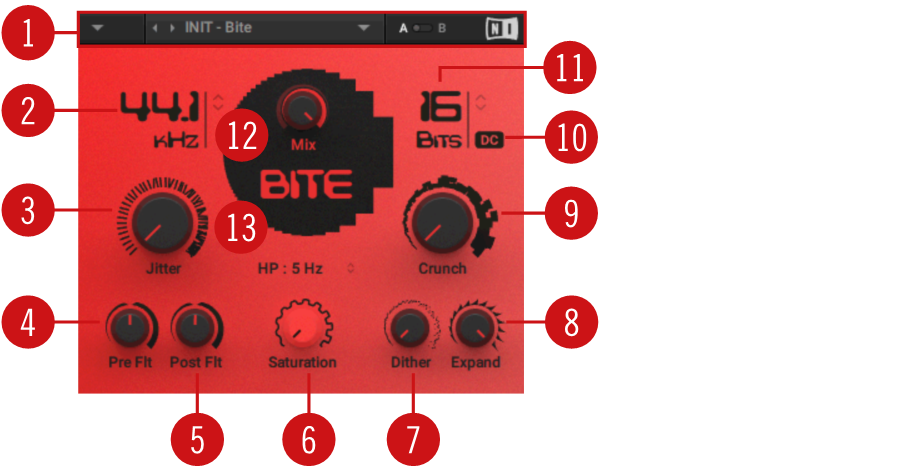BITE
BITE distorts sound by resampling digital audio signals at a lower bit rate and therefore lowering their resolution. This section includes a note about bit and sample rate reduction effects and an overview of the BITE plug-in.
In this chapter you can learn about BITE. It includes a general note about bit and sample rate reduction effects and an overview of the BITE plug-in.
About Bit and Sample Reduction Effects
Bit reduction effects are used to distort sound by resampling digital audio signals at a lower bit rate and therefore lowering their resolution. This degrades the audio signal and gives it a quality resembling pulse wave signals. At low settings, bit crushing produces harsh distortion, while higher settings simulate the “vintage” sound of older drum machines and samplers.
Sample rate reduction effects (also called down-sampling) convert the digital audio signal to a lower sample rate, adding distortion and aliasing to the sound. This can be used to achieve low-fi effects that emulate vintage studio equipment or to simply add grittiness to the sound. Extreme reductions completely break the integrity of the signal beyond recognition.
Bit and sample rate reduction effects can intentionally be used to not only reduce the resolution and bandwidth of the signal but also attenuate the high frequencies, or add noise with a certain “bite” to the sound. BITE combines the two techniques in a single plug-in, making it possible to add complex textures to the signal or completely deteriorate the sound in many different ways.
Overview of BITE
BITE is an anti-aliased sample rate and bit reduction effect that can be used to create distortion effects that sound like vintage studio equipment, or inherently lo-fi sound sources, like old video games. It simulates the audio being sampled and replayed using a low-quality sampler with limited sample rate and bit depth.
BITE is divided into two sections that control the resampling frequency (kHz) and the bit depth (Bits). As a special feature, the Crunch control adjusts the level going into the bit reduction algorithm, providing a smooth way to control the resolution without stepping effects.
The resampling algorithm also includes stereo clock jittering (Jitter), and the bit reduction algorithm provides stereo dither noise (Dither), allowing you to create a wide stereo image from any source. The additional controls for filtering and saturation allow you to fine-tune the behavior of the effect.

Header: Provides global functions related to preset management and plug-in behavior. For more information, refer to Header and Presets.
Freq: Adjusts the sampling frequency at which the input signal is resampled in a range of 0.1 kHz to 44.100 kHz.
Jitter: Adjusts the amount of clock jitter. This adds fluctuations to the sampling rate of the resampling algorithm, effectively making the signal noisier. The jitter is added to the left and right stereo channels independently, resulting in a wide stereo image for the noise component.
Pre Filter: Adjusts the cutoff frequency of a low-pass filter that is applied to the input signal. You can use it to remove frequencies that would produce aliasing noise in the resampling algorithm. At center position, the cutoff frequency is half of the sampling frequency. Its range is from 50 Hz to 22050 Hz.
Post Filter: Adjusts the cutoff frequency of a low-pass filter that is applied to the output signal. You can use it to remove aliasing noise. At center position, the cutoff frequency is half of the sampling frequency. Its range is from 50 Hz to 22050 Hz.
Saturation: Drives the quantized signal into a saturator and compensates for the loudness increase caused by the saturation.
Dither: Adjusts the amount of noise that is added to the resampled signal to reduce distortion caused by quantization errors. In this effect, the noise amount can be increased for creative purposes. Independent noise sources are used for left and right stereo channels, resulting in a wide stereo image for the noise component.
Expand: Changes the distribution of the quantization values in the amplitude range. When set fully to the left, low-level signals are quantized at a higher resolution. When set fully to the right, the resolution available for quantizing low-level signals is reduced, effectively turning them into pulse waves.
Crunch: Provides continuous control over the bit reduction effect, reducing the amount of used quantization values by lowering the signal level before the bit reduction algorithm. This allows you to smoothly control the resolution without stepping effects.
DC: Toggles between two different modes for the quantization of the input signal according to the bit depth (Bits). When activated, the zero level is removed from the available bit values, effectively sustaining the sound with a buzzing square wave. When deactivated, the output signal fades to silence immediately.
Depth: Adjusts the amount of available quantization values by setting the bit depth in the range of 2 bits to 16 bits. Each sample of the signal is quantized to the available values. A lesser amount of values results in a more distorted sound.
Mix: Blends between the dry signal and the wet signal by means of an equal-power crossfade.
HP: Adjusts the cutoff frequency of a 1-pole high-pass filter that is applied to the output signal. It aims remove low-frequency and DC components from the signal. It provides three cutoffs 5 Hz, 100 Hz and 200 Hz.